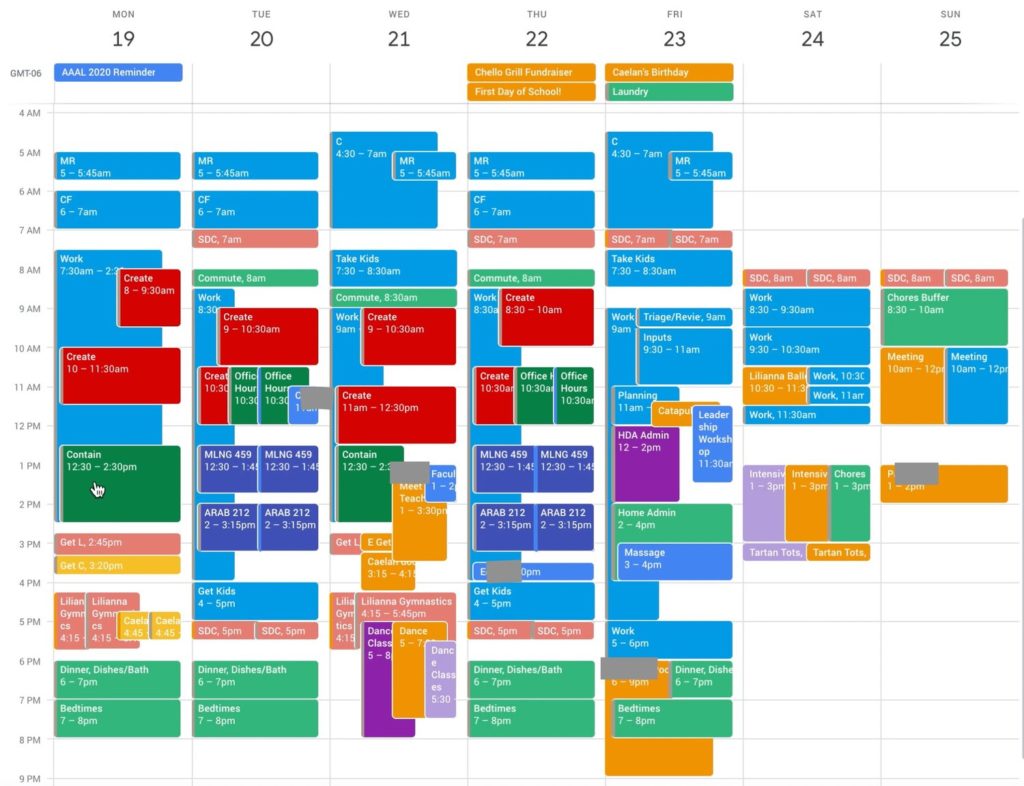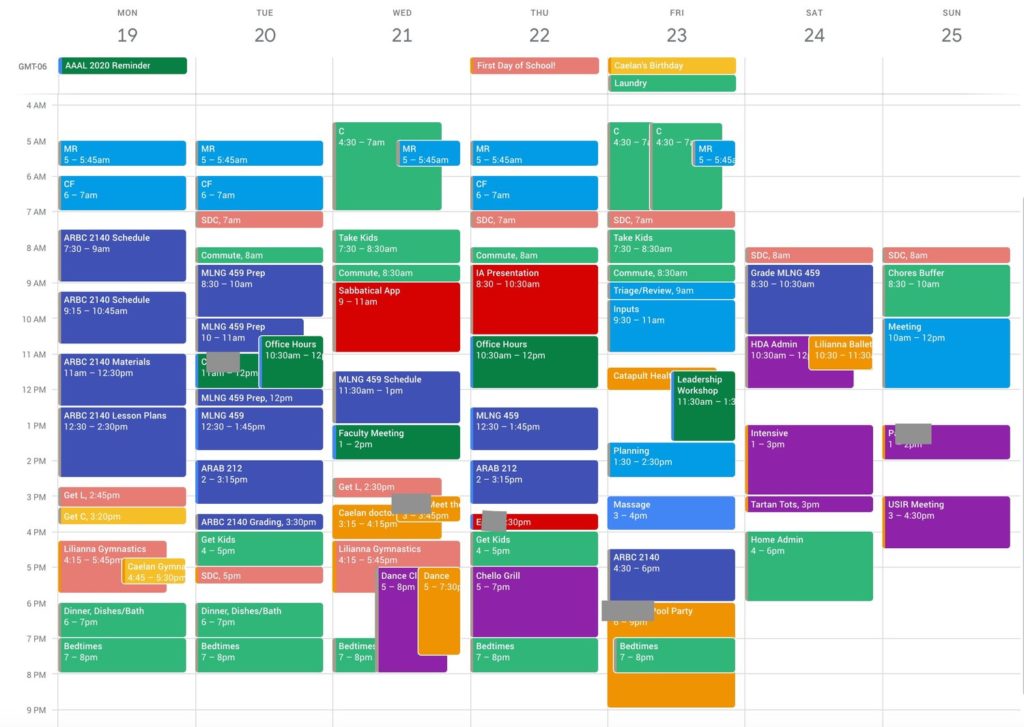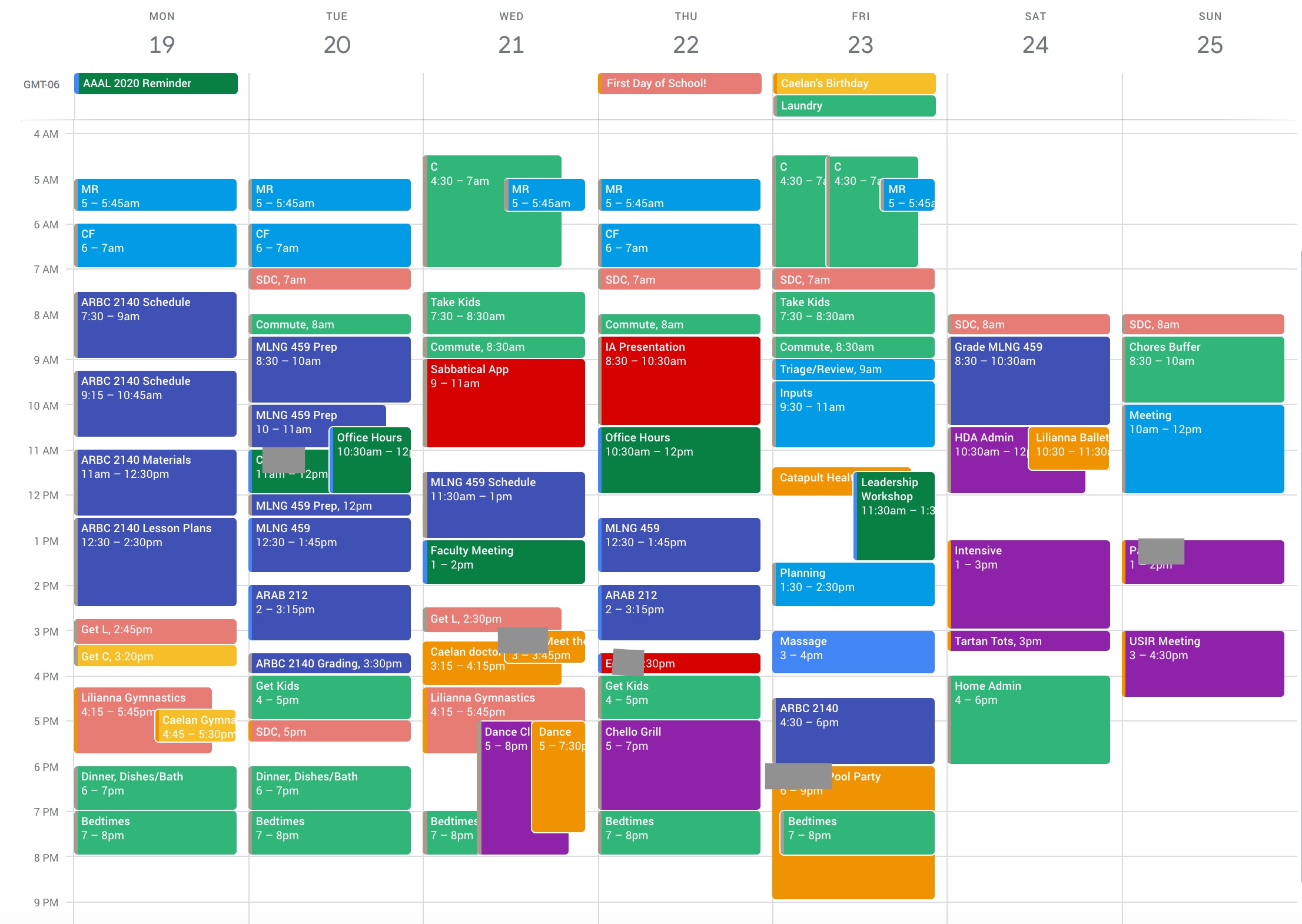If I had to choose one piece of productivity advice, it would probably be weekly planning! I talked about weekly planning and daily adjustments almost a year ago, but I’ve had some questions recently from friends about how I actually do my weekly planning process, so I thought I’d share it here. In my process, there are four key components to weekly planning:
1) Doing it weekly (maybe this is obvious, but it is really the most important thing)
2) Making a weekly task list
3) Mapping it onto the week (time-blocking to align with my ideal week)
4) Buffer time (because who knows what will happen!)
So, here is my process at the moment (it’s changed over time, even as the weekly planning has remained consistent for the last four years or so).
Doing it weekly
My preferred time is Friday mornings, and I have this blocked in my ideal weekly calendar that I will talk about below. I like Friday mornings because it gives me an idea of what I have to finish before the weekend and time to finish it (as opposed to if I did this Friday afternoon, I might run out of time). It also means I don’t have to spend too much mental energy on the weekend worrying about the following week, which makes it easier for me to focus on family, home, and dance activities.
So, what if I can’t do it at my preferred time? I just choose another time of the week, usually Thursday, Saturday, or Monday, but maybe another day depending on the schedule. The important think is weekly, not the particular day.
How long does it take? Now, the entire process takes me about 2.5 hours, although I rarely do it in a solid 2.5 hour blog. When I first started, it took longer, maybe 4-5 hours as I figured out my process. This is usually intimidating to people, because if you feel like you are short on time, where do you get 4 hours to plan? However, I do feel like this gives me more time in the long run, and more importantly, less worry about what I’m doing.
Making a weekly task list
My first task is making my “triage” list, which is a set of 8 lists on a piece of paper, as in the picture.

Row 1:
- Today: Things that have to happen today, no exceptions (not what I would like to happen today)
- Weekend: Tasks and events for the weekend
- Next Week: Tasks and events for next week
Row 2:
- Shopping: Things I need to buy this week
- Beyond: Things that need to happen, but later than next week
Row 3: (I try to have one block for each category each weekend):
- Home: List of home tasks for the weekend
- Work: List of work tasks for the weekend
- Dance: List of dance tasks for the weekend
Next, I fill out these lists by going the various ways in which information comes to me as well as my Trello and paper workboxes. There are A LOT of ways information comes to me, and I actually had to make a list, pictured below. The left side is paper inputs, and the right side digital. Yikes! This step takes about two hours, about 1.5 of which is clearing email.

Once I’m done with that, my list looks more like this:

Mapping it onto the week
Next, I take these tasks and map them onto my week using Google Calendar. I’ve developed a fairly complex system of using multiple calendars to plan my week, but it is working well for me because each calendar can be displayed alone or with others for different perspectives on my time. These include:
- School Calendar: I subscribe to my daughter’s school calendar.
- Event Calendar: This is all my scheduled events—personal, dance, work.
- Family Calendar: This is all scheduled family events, as well as any personal, work, or dance events that occur during non-school/daycare hours.
- Weekly Plan: This is what my ideal week would look like, it repeats weekly.
- Family Weekly Plan: This is our work/activity/drop-off and pick-up schedules in an ideal week. I have copied my duties from this one to my weekly plan, so I usually don’t have this one visible, but can refer to it.
- Dance Calendar: This is my dance event calendar, which my dancers can also subscribe to.
So, what is the actual mapping process? I tried to take a video, but alas my computer could not handle videoing my screen while I did this, so I’m using screen shots instead.
1) Look at the school calendar and copy anything relevant to my daughter’s grade to the Family Calendar. Then I hide the school calendar.
2) I show my event calendar, family calendar, dance event calendar, and weekly plan.

Then I start mapping the activities from my “Weekend” and “Next Week” lists onto the calendar, though the next weekend. On my weekly plan, you can see that I have “Create” and “Contain” blocks, this basically has to do with my energy level—I need more energy to create things like articles or lesson plans than grade. So, as I start mapping the activities on, I try to place them accordingly on that part of the weekly plan. A key part of this mapping is having realistic time estimates—I usually try to put 1.5 times what I think the task will take, but this is a skill that develops with time. If you’re just starting out, you can skip the ideal week calendar, I just find this helps me align what I do with what I want to be doing and what my energy levels and different times of day will allow me to do.

This looks crazy, but once I have everything plotted on, I delete the generic blocks from the weekly plan and color code the task according to activity. This leaves me with a weekly plan! I used to copy this to a paper calendar to set it in my mind, but recently I’ve just been using the Google one, and mostly referring to it on my phone.

Buffer Time
This is technically part of the weekly mapping, but I’ve discovered it’s so important that I wanted to leave it as a separate category. Essentially, I try to leave some open blocks (usually on Thursday, Friday, and Saturday) for things that come up during the week that I don’t know about yet, or tasks for which I underestimated the time. This is really challenging to do, as you can see in the schedule below, it’s really only Thursday morning during office hours and bits of Friday and Saturday that are open.
I still adjust this daily, as described in my previous post. For example, during this actual week, my son was sick on Wednesday, I underestimated prep time (still after so many years!), and I added in several student appointments and a call about an arts grant for our local Celtic Festival. On the other hand, some of the grading took less time (yay!). So, I used my Thursday buffer for prep, and pushed some other tasks to the following week, and finished by 11:30 Saturday.
Do you do weekly planning? If so, what is your system? Is there anything in my system you’d like to try?

Leave a Reply